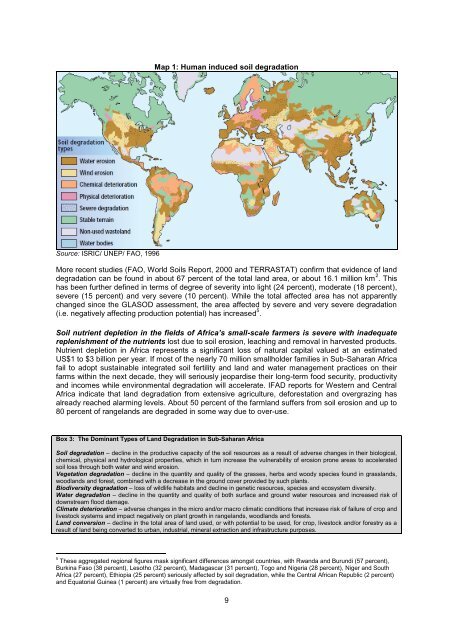The CAADP Pillar I Framework
The CAADP Pillar I Framework
The CAADP Pillar I Framework
- No tags were found...
Create successful ePaper yourself
Turn your PDF publications into a flip-book with our unique Google optimized e-Paper software.
Map 1: Human induced soil degradationSource: ISRIC/ UNEP/ FAO, 1996More recent studies (FAO, World Soils Report, 2000 and TERRASTAT) confirm that evidence of landdegradation can be found in about 67 percent of the total land area, or about 16.1 million km 2 . Thishas been further defined in terms of degree of severity into light (24 percent), moderate (18 percent),severe (15 percent) and very severe (10 percent). While the total affected area has not apparentlychanged since the GLASOD assessment, the area affected by severe and very severe degradation(i.e. negatively affecting production potential) has increased 5 .Soil nutrient depletion in the fields of Africa’s small-scale farmers is severe with inadequatereplenishment of the nutrients lost due to soil erosion, leaching and removal in harvested products.Nutrient depletion in Africa represents a significant loss of natural capital valued at an estimatedUS$1 to $3 billion per year. If most of the nearly 70 million smallholder families in Sub-Saharan Africafail to adopt sustainable integrated soil fertility and land and water management practices on theirfarms within the next decade, they will seriously jeopardise their long-term food security, productivityand incomes while environmental degradation will accelerate. IFAD reports for Western and CentralAfrica indicate that land degradation from extensive agriculture, deforestation and overgrazing hasalready reached alarming levels. About 50 percent of the farmland suffers from soil erosion and up to80 percent of rangelands are degraded in some way due to over-use.Box 3: <strong>The</strong> Dominant Types of Land Degradation in Sub-Saharan AfricaSoil degradation – decline in the productive capacity of the soil resources as a result of adverse changes in their biological,chemical, physical and hydrological properties, which in turn increase the vulnerability of erosion prone areas to acceleratedsoil loss through both water and wind erosion.Vegetation degradation – decline in the quantity and quality of the grasses, herbs and woody species found in grasslands,woodlands and forest, combined with a decrease in the ground cover provided by such plants.Biodiversity degradation – loss of wildlife habitats and decline in genetic resources, species and ecosystem diversity.Water degradation – decline in the quantity and quality of both surface and ground water resources and increased risk ofdownstream flood damage.Climate deterioration – adverse changes in the micro and/or macro climatic conditions that increase risk of failure of crop andlivestock systems and impact negatively on plant growth in rangelands, woodlands and forests.Land conversion – decline in the total area of land used, or with potential to be used, for crop, livestock and/or forestry as aresult of land being converted to urban, industrial, mineral extraction and infrastructure purposes.5 <strong>The</strong>se aggregated regional figures mask significant differences amongst countries, with Rwanda and Burundi (57 percent),Burkina Faso (38 percent), Lesotho (32 percent), Madagascar (31 percent), Togo and Nigeria (28 percent), Niger and SouthAfrica (27 percent), Ethiopia (25 percent) seriously affected by soil degradation, while the Central African Republic (2 percent)and Equatorial Guinea (1 percent) are virtually free from degradation.9
















